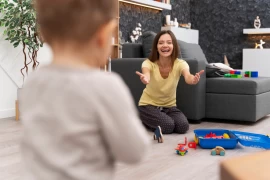
On Occupational Therapy
- On Occupational Therapy
- What is Occupational Therapy?
- For Which Age Groups Is Occupational Therapy Applied?
- What are the Uses of Occupational Therapy in Children?
- What are the Occupational Therapy Application Methods in Children?
What is Occupational Therapy?
Occupational therapy is a rehabilitation method used to increase the independence of individuals in their daily living activities (GA) and work, to improve their quality of life and to improve their general health. Occupational therapy seeks to improve a person's physical, mental and emotional functioning by developing a customized treatment plan tailored to the individual's needs and goals.
Occupational therapy is used to treat people with physical and mental disabilities, particularly brain injury, stroke, musculoskeletal disorders, rheumatoid arthritis, multiple sclerosis, Parkinson's disease, and various neurological, orthopedic and psychiatric conditions. This method of treatment uses a variety of activities and exercises to increase a person's independence and performance in activities of daily living.
Occupational therapy is generally applied by occupational therapists. In some cases, occupational therapy may need to be carried out in a multidisciplinary team approach with occupational therapists, speech therapists, psychologists and other health professionals.
For Which Age Groups Is Occupational Therapy Applied?
Occupational therapy can be applied to people of all age groups. This treatment method can be used in a wide range from infants to the elderly.
Occupational therapy for early childhood can be used to support children's developmental stages and improve their motor skills. Occupational therapy for school-age children can be used to improve learning, writing and reading skills, increase attention and concentration, and increase independence in activities of daily living.
Occupational therapy in adults can be used to rehabilitate after illness or injury, improve performance at work and improve quality of life. Occupational therapy for the elderly can be used to reduce the risk of falls, increase social connections and improve quality of life.
Occupational therapy offers a customized treatment plan for people of all age groups and is tailored to the individual's needs and goals.
What are the Uses of Occupational Therapy in Children?
Occupational therapy has various uses to support children's motor skills, cognitive functions, social and emotional development. Some examples are:
- Developmental Delay: Children can be supported in areas with developmental delays with occupational therapy. These areas may include areas such as eating and drinking skills, hand-eye coordination, walking and running skills, balance and coordination, and daily living skills.
- Attention and Concentration: Occupational therapy uses various techniques to increase children's attention and concentration. These techniques may include, for example, working with sensory stimuli, organizing workspaces and playing games to increase learning and reading skills.
- Autism Spectrum Disorder: Occupational therapy can offer customized treatment plans for children with autism spectrum disorders. These treatment plans may include areas such as increasing social interactions, managing sensory stimuli, and improving daily living skills.
- Down Syndrome: Occupational therapy can be used to improve motor skills, sensory processing skills and self-care skills of children with Down syndrome.
Occupational therapy offers a treatment plan customized to children's individual needs and goals and helps children develop in their best way.
What are the Occupational Therapy Application Methods in Children?
Occupational therapy methods in children differ according to factors such as the child's age, needs and treatment goals. But in general, methods of applying occupational therapy in children may include:
- Play-Based Therapy: Children often learn through games, so occupational therapy can also use play-based therapy methods. This method can support areas such as motor skills, hand-eye coordination, social interaction, attention and concentration by using games that will attract the child's attention.
- Sensory Integration Therapy: Sensory integration therapy helps develop the child's ability to process sensory stimuli. This therapy targets all sensory systems such as the senses of touch, hearing, sight, smell and taste. This method may be effective in situations where children have problems processing sensory stimuli, such as autism spectrum disorder, sensory processing disorder, and other neurological conditions.
- Dexterity Development: Occupational therapy can also be used to improve children's manual dexterity. This method can help children develop fine motor skills by working with materials such as pencils, scissors, string and buttons.
- Developing Daily Living Skills: Occupational therapy can also be used to improve children's daily living skills. This method can help increase independence in activities of daily living such as dressing, eating and drinking, bathing and cleaning.
- Improving School Performance: Occupational therapy can also be used to improve the learning, reading and writing skills of school-age children. This method can positively affect school performance by increasing the attention and concentration of children.
Occupational therapists choose appropriate application methods by creating a treatment plan according to the individual needs of children.


